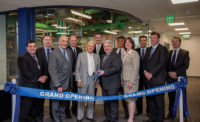Watts presents innovative water solutions
Watts and rep firm Mid-America Marketing host Nashville event aimed at navi-gating the changing world of premise plumbing design.

Watts’ Gaurav Mathur (left) and Mid-America Marketing’s Lloyd Rainey show off Watts’ flood protection system in Nashville. Photo courtesy of Watts.
Watts Vice President, Global Electronics and Water Quality Platforms Nick Ganzon likens the industry’s involvement in product connectivity in commercial settings, particularly premise plumbing systems in health-care facilities, to a baseball game.
“In terms of connectivity and talking about water-borne pathogens in systems, we probably are in the first or second innings,” he said. “It’s early. Building automation systems typically are used with electrical and fire suppression. There’s not a lot going on right now with premise plumbing.”
Ganzon and Watts are out to change that. The North Andover, Massachusetts-based manufacturer proved that in one of its latest customer symposiums held in Nashville, Tennessee, in April at the Gaylord Opryland Resort. Watts and its Nashville-based rep agency Mid-America Marketing hosted the event.
The Nashville symposium featured concurrent educational sessions and a series of six Watts solution stations. CEU credits were available for Legionella control, digital mixing valve technology evolution and water-quality systems. Legionella control was one of the six solution stations, along with drain solutions, Watts Works Learning Center and educational support, fire and flood protection, water filtration and treatment solutions, and a station dedicated to Powers IntelliStation systems.
Ganzon said when it comes to the connectivity piece, water-borne pathogens are at the top of Watts’ most-wanted solutions list.
“You think about water-borne pathogens, inorganics such as heavy metals and on the organic side its PFAs — plastics in the water supply,” he said. “We are spending a lot of time on this, especially with waterborne pathogens. It exemplifies where we want to go from a connected strategy. If you go into a health-care facility there are a number of disparate systems. What we are trying to do is maintain control of that premise plumbing supply and make sure all systems are operating within their parameters. A facility may have all these systems working independently. We want to take them and get them working together so there is that ability to minimize the presence of those pathogens.”
Carlos Haddad, Watts’ vice president of marketing for North America and Europe, pointed out during the Nashville symposium that the number of cases of Legionella continues to rise.
“Every year we are seeing an increase,” he said. “This is an opportunity for us to connect the systems, and give visibility into the systems, which allows us to play an important role in this sector. We know Legionella cases keep growing, but now there are ways for us to connect these systems and monitor them much better.”
Ganzon added that as Watts moves further down the connected premise-plumbing system path, simplicity for the end user is a must. “We have to get down to the essence and make them as simple to use as possible so there is not a high barrier or a pressure to make them work.”
Ganzon and Haddad see further major growth opportunities for Watts when it comes to this subject. “We want to see sensor technology throughout the premise plumbing system so we can monitor,”Ganzon said. “We would have some level of monitoring on water-quality systems. If my scale control system goes offline, I have to react or scale will start building on the water heater and pipe and help propagate pathogens. I see us giving forewarning to service that system. Also, we’ll get to the point where we can better control how frequently we are changing point-of-use filters. In the next three to five years there will be a lot of emerging technologies in this space.”
Looking for a reprint of this article?
From high-res PDFs to custom plaques, order your copy today!






